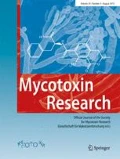Abstract
In Argentina, due to climatic conditions, Fusarium head blight (FHB) caused by Fusarium graminearum, affected the 1993/94 wheat crop. To evaluate the severity of this disease, samples of wheat where gathered from four zones of the wheat area. Sanitary conditions and mycotoxin contamination were determined. One zone (IIN) was intensely affected by FHB with 90% of samples in grade III (bad quality). No samples were grade I (good quality). The other zones were less affected falling into grade I or II (moderate quality). In all samples tested F. graminearum was the most prevalent species singly or in combination with others. Zone II N, with a DON mean level of I1.26 ppm, did not fulfil aceptability limits, whereas zones IIS, III and IV with overall means of 2.12, 1.57 and 1.0 ppm, respectively, did. Statistical analysis showed a close relation between percentage FHB and DON contamination (r:-0.71, p<0.01) in infected samples.
Similar content being viewed by others
References
Galich M and Galich A (1994) Enfermedades del tri go en el area sur de Santa Fé y Córdoba, subregión II N 1993/94. Inf Exten N° 5 EEA Marco Juárez
Schroeder H and Christensen J (1963) Factors affecting resistance of wheat to scab caused byFusarium graminearum (perfect stateGibberella zeae). Phytopathology 53:831–838
Tuite J, Shaner G and Everson RJ (1990) Wheat scab in soft red winter wheat in Indiana in 1986 and its relation to some quality measurements. Plant Dis 74:959- 962
Snijders CHA (1990) Fusarium head blight and mycotoxin contamination of wheat, areview. Neth J Pl Path 96:187–198
Neish GA, Cohen H (1981) Vomitoxin and zearalenone production byFusarium graminearum from winter wheat and barley in Ontario. Can J Plant Sci 61:811–815
TanakaT (1988) World wide contamination of cereal by the Fusarium mycotoxins nivalenol, deoxynivalenol and zearalenone. I. Survey of 19 countries. J Agric Food Chem 36:979–983
Reiss EM (1988) Doencas do trigo III. Giberella. 2a Edition revista e ampliada, Brasil: 13
van Egmond HP (1989) Current situation on regulations for mycotoxins. Overview and status of standard methods of sampling and analysis. Food Addit Contam 6:139–188
Davis ND, Dickens JW, Freie RL, Hamilton PB, Shotwell OL, Willie TD, Fulkeson JF (1980) Protocols for surveys, sampling, post-collection handling, and analysis of grain samples involved in mycotoxin problems. J Assoc Off Anal Chem 63:95–102
Neergaard P (1974) Report of the fourth regional workshop on seed pathology for developing countries. Danish Government Inst Seed Pathol for developing countries, Denmark, 22p
BoothC (1971) The genusFusarium.Commonwealth. Mycol Inst, Kew, England, 237 pp
Nelson PE, Toussoun TA and Marasas WFO (1983)Fusarium species and ilustrated manual for identification. Pennsylvania State University Press. University Park Pa, 193 pp
Rizzo I, Kneteman E, Salom R, Frade AH (1995)Thin layer chromatography for the determination of T-2, neosolaniol and DON in wheat flour and by-products. International Seminar onFusarium, May 9–13, Martina Franca, Italy:54
Scott PM (1990) Natural Poisons. In AOAC Official Methods of Analysis 15th edition Chapter 46:1190
Ross PF, Nelson PE, Richard JL, Osweiler GD, Rice LG, Plattner RD, Wilson TM (1990) Production of fumonisins byFusarium moniliforme andFusarium proliferation isolates associated with equine encephalomalacia and pulmonary edema syndrome in swine. Appl Environ Microbiol 56:3225–3226
Lori GA, Carranza MR, Violante A, Rizzo I, Alippi HE (1992)Fusarium spp. en trigo, capacidad toxicogénica y quimiotaxonomía de las cepas aisladas en la Argentina. Agronomie 12:459–467
Author information
Authors and Affiliations
Rights and permissions
About this article
Cite this article
Rizzo, I., Lori, G., Vedoya, G. et al. Sanitary factors and mycotoxin contamination in the argentinian wheat crop 1993/94. Mycotox Res 13, 67–72 (1997). https://doi.org/10.1007/BF02945068
Received:
Accepted:
Issue Date:
DOI: https://doi.org/10.1007/BF02945068




